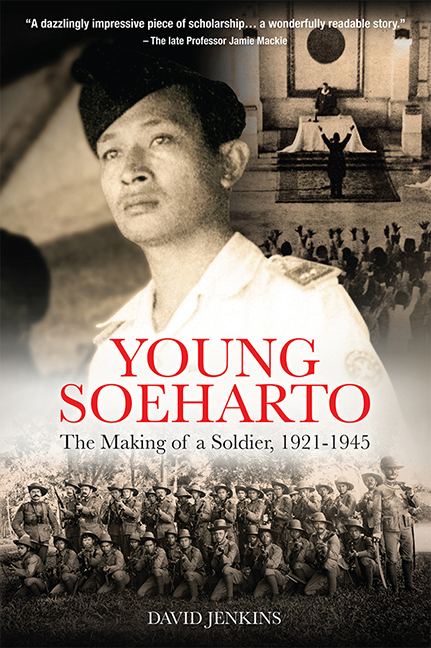Book contents
- Frontmatter
- Contents
- Foreword
- A Note on Spelling and Names
- A Note on Military Organization
- Maps
- List of Charts
- Preface
- Soeharto Family Tree
- 1 “The Sultan came to me and asked about that Family tree”
- 2 “The Cork on which the Netherlands Floats”
- 3 “They Regard Holland as a very Weak Power”
- 4 “An Invisible Motivating Force”
- 5 “What kind of Islam is this?”
- 6 “Soeharto is a Closed Book”
- 7 “I was Suited to the Disciplined life of the Military”
- 8 A Reassuringly Familiar World
- 9 A Policeman for the Japanese
- 10 An Armed Force Conjured out of Nothing
- 11 “The whole Island was Ablaze with Enthusiasm”
- 12 “Don’t make them too Strong!”
- 13 “Soeharto was a Cautious Man”
- 14 “Why did they Choose Soeharto?”
- Glossary and Abbreviations
- Notes
- Acknowledgements
- Bibliography
- Index
- About the Author
10 - An Armed Force Conjured out of Nothing
Published online by Cambridge University Press: 09 October 2021
- Frontmatter
- Contents
- Foreword
- A Note on Spelling and Names
- A Note on Military Organization
- Maps
- List of Charts
- Preface
- Soeharto Family Tree
- 1 “The Sultan came to me and asked about that Family tree”
- 2 “The Cork on which the Netherlands Floats”
- 3 “They Regard Holland as a very Weak Power”
- 4 “An Invisible Motivating Force”
- 5 “What kind of Islam is this?”
- 6 “Soeharto is a Closed Book”
- 7 “I was Suited to the Disciplined life of the Military”
- 8 A Reassuringly Familiar World
- 9 A Policeman for the Japanese
- 10 An Armed Force Conjured out of Nothing
- 11 “The whole Island was Ablaze with Enthusiasm”
- 12 “Don’t make them too Strong!”
- 13 “Soeharto was a Cautious Man”
- 14 “Why did they Choose Soeharto?”
- Glossary and Abbreviations
- Notes
- Acknowledgements
- Bibliography
- Index
- About the Author
Summary
The Japanese had had much to celebrate in the days after the Sixteenth Army landed in Java in March 1942. The island at the heart of the Dutch East Indies had fallen into their hands after a land campaign lasting a little more than a week. Elsewhere, the forces of the Imperial Army and the Imperial Navy were carrying all before them, from the Andaman Islands in the Bay of Bengal to the Solomon Islands in the South Pacific. But success in war is often fleeting, and by mid-1942 the war was starting to go badly for Japan. An almost unbroken string of Japanese military triumphs had come to an abrupt halt at the Battle of Midway in early June, almost six months to the day after the opening strike against Pearl Harbor and only three months after the Japanese landings in Java. At Midway, the Imperial Navy lost four of its largest aircraft carriers in one day; the US Navy lost only one. It was a blow from which the Japanese would never recover.
As 1942 wore on, the Japanese Southern Army, which had primary responsibility for Burma, Malaya, Sumatra, Java, British North Borneo and the Philippines, and which maintained garrison armies in French Indochina and Thailand, found itself increasingly cut off from the Japanese home islands as a result of US submarine attacks on Japanese merchant shipping. As a result, Java assumed even greater importance as a supply base, for food, raw materials and manpower. But as the Japanese were well aware, Java was itself vulnerable. During the six months he spent on Java, General Imamura was, as we have seen, “keenly expecting” an Allied attack on Java from bases in Australia. And as he knew only too well, his “ten battalions of aged soldiers” would be quite insufficient in the event of any such attack. Those concerns remained after Imamura was transferred to Rabaul.
One solution to the manpower problem was to create an indigenous army of some kind, using either conscripts or volunteers, as the Japanese had done when they founded the Indian National Army and the Burma Independence Army at the end of 1941. But the Japanese were not sure that Indonesians were physically or temperamentally suited to military service.
- Type
- Chapter
- Information
- Young SoehartoThe Making of a Soldier, 1921–1945, pp. 206 - 220Publisher: ISEAS–Yusof Ishak InstitutePrint publication year: 2021



